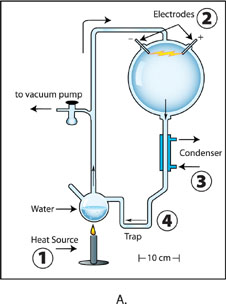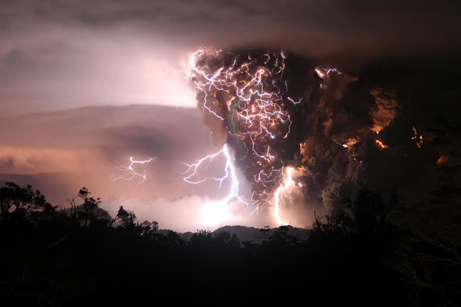[/caption]
Maybe the fictional Dr. Frankenstein wasn’t so crazy after all. Two scientists have resurrected an old experiment, breathing life into a “dead” notion about how life began on our planet. New analysis shows that lightning and gases from volcanic eruptions could have given rise to the first life on Earth.
“It’s alive!”…
Back in the early 1950s, two chemists Stanley Miller and Harold Urey of the University of Chicago did an experiment that tried to recreate the conditions of a young Earth to see how the building blocks of life could have arisen. They used a closed loop of glass chambers and tubes with water and different mixes of hydrogen, ammonia, and methane; the gases thought to be in Earth’s atmosphere billions of years ago. Then they zapped the mixture with an electrical current, to try and confirm a hypothesis that lightning may have triggered the origin of life. After a few days, the mixture turned brown.
When Miller analyzed the water, he found it contained amino acids, which are the building blocks of proteins — life’s toolkit. The spark provided the energy for the molecules to recombine into amino acids, which rained out into the water. The experiment showed how simple molecules could be assembled into the more complex molecules necessary for life by natural processes, like lightning in Earth’s primordial atmosphere.

But there was a problem. Theoretical models and analyses of ancient rocks eventually convinced scientists that Earth’s earliest atmosphere was not rich in hydrogen, so many researchers thought the experiment wasn’t an accurate re-creation of early Earth. But the experiments performed by Miller and Urey were ground-breaking.
“Historically, you don’t get many experiments that might be more famous than these; they re-defined our thoughts on the origin of life and showed unequivocally that the fundamental building blocks of life could be derived from natural processes,” said Adam Johnson, a graduate student with the NASA Astrobiology Institute team at Indiana University, Bloomington. Johnson is the lead author on a paper that resurrects the old origin-of-life experiments, with some tantalizing new findings.
Miller died in 2007. Two former graduate students of Miller’s –geochemists Jim Cleaves of the Carnegie Institution of Washington (CIW) in Washington, D.C., and Jeffrey Bada of Indiana University, Bloomington–were examining samples left in Miller’s lab. They found the vials of products from the original experiment and decided to take a second look with updated technology. Using extremely sensitive mass spectrometers at NASA’s Goddard Space Flight Center Cleaves, Bada, Johnson and colleagues found traces of 22 amino acids in the experimental residues. That is about double the number originally reported by Miller and Urey and includes all of the 20 amino acids found in living things.
Miller actually ran three slightly different experiments, one of which injected steam into the gas to simulate conditions in the cloud of an erupting volcano. “We found that in comparison to Miller’s classic design everyone is familiar with from textbooks, samples from the volcanic apparatus produced a wider variety of compounds,” said Bada.
This is significant because thinking on the composition of Earth’s early atmosphere has changed. Instead of being heavily laden with hydrogen, methane, and ammonia, many scientists now believe Earth’s ancient atmosphere was mostly carbon dioxide, carbon monoxide, and nitrogen. But volcanoes were active during this time period, and volcanoes produce lightning since collisions between volcanic ash and ice particles generate electric charge. The organic precursors for life could have been produced locally in tidal pools around volcanic islands, even if hydrogen, methane, and ammonia were scarce in the global atmosphere.
So, this breathes life into the notion of lightning jump-starting life on Earth. Although Earth’s primordial atmosphere was not hydrogen-rich, gas clouds from volcanic eruptions did contain the right combination of molecules. Is it possible that volcanoes seeded our planet with life’s ingredients? While no one knows what happened next, the researchers are continuing their experiments in an attempt to determine if volcanoes and lightning are the reasons we’re here.
The paper was published in Science on Oct. 17, 2008
Sources: NASA, ScienceNOW


I still feel a bacteria laced asteroid sounds better…
I like it. Simply, the technical term should be……
Gaea cardio defibrillation
(with copyright pending)
Good old Occam and his razor. The simple ideas are the most elegant. Who needs supernatural beings, aliens, or bits of interstellar bacteria? Broth, brimstone, and a bolt of lightning works just fine!
Originally available from Scripps UCSD.
Heh, maybe next time I’ll just e-mail Nancy directly.
http://scrippsnews.ucsd.edu/Releases/?releaseID=930
Brrr…
But it’ s a good discovery after all.
I most surely don’t. I much prefer a local origin for life (implying that it can originate anywhere with the same set of conditions) to an extraterrestrial one, which simply transfers elsehwere the how and when of the origin of life and implies that the beginnings are much harder. Theories of a local origin provide more complete explanations of the whole process. Not that panspermia is impossible, but it’s much less likely than the local origin.
Such a beautiful experiment. As mentioned, so simple and yet so profound… And the fact that they discovered every single amino acid present in life from such basic initial conditions? It just speaks, nay – shouts for itself…
I might set one up myself just because it’s awesome.
It’s a shame Miller himself didn’t think to do it before his death. It would have delighted him, I’m sure…
Astrofiend:
Both the UCSD release I linked to earlier, and the Universe Today article say that Miller performed several experiments, and that these results were obtained from one of Millers original experiments.
Two of his students found the vials with the products from the original experiments, and re-did the analysis with modern equipment.
Was Miller’s experiment reran using our current understanding of the atmospheric gases at the time life arose? If so what were the results?
I wonder if Miller and Urey were correct when they reported the 12 amino acids back in the fifties? Maybe the others have just slowly formed over the intervening years. I don’t know, it’s just a thought.
See what happens when you drop your child on his head?
Cardio would assume there is a heart created in the process. Defibrilliation would assume there is some sort of fibrillation, or in other words a mass quantity of nothing working together. In this case, it is obvious things ARE WORKING TOGETHER… The prefix adding you were some how stopping the lack of work…again which is wrong since things are already working together.
…i think your patent is safe, since it wouldn’t get past the high school educated clerk.
If there are any geo-chemists out there…
I’m having problems believing there was any great amount of water in either scenarios. With the lack of hydrogen, and the way carbon binds to oxygen, I’m a bit baffled. Where did the water come from?
If hydrogen was present in the early “upper” atmosphere I could see it. Obviously, with the mix coming from volcanos it isn’t going to be settling near the surface of the earth.
…and I’m still looking for anyone who has a good theory on where the nitrogen in early earth came from.
I’m open to any theories.
It is possible that the lightning can also be found in gas and dust clouds in interstellar space. The lightning being provided by ultraviolet radiation from stars forming in the gas clouds which makes the Urey- Miller model even more practical for planetside and in space. More power to Jim Cleaves and Jeffrey Bada for reexamining the old test results. I look forward to more exciting news on this subject in due course.
Finding these building blocks is exciting, but still the real problem and requirement is for them to become ‘alive’. What processes are required to meet the minimum requirements for life? What are the chances of creating a naturally occurring condition to form DNA and whatever else is needed?
I remember the article in the Scientific American, as I recall about 1958; it was assumed that the early earth had a methane atmosphere. Glad to read the updates in this fine piece. Thanks MOK
Recently Scientific American had an article describing that various groups around the world are actually looking for evidence of multiple origins of life. If they could find some microscopic organism (bacteria or virus) that had a different chemistry such as amino acids or even genetic code then they’ll have evidence that life started multiple times on Earth rather than just once. If life truly came into existence around volcanoes then the multiple origin hypothesis is more probable.
They keep saying Titan is an analog for the early Earth, and it has loads of methane and ethane. So what is it? No hydrogen or boatloads of hydrogen? I guess we’ll need a time machine to know for sure.
Aodhhan – They say the water on Earth probably came from comets so there should have been plenty of it at the time.
If Ethane in Titans atmosphere is formed primarily through photolysis of Methane, What do you think the other product’s going to be.
It takes 2 methanes to make an ethane by photolysis, but two methanes have 8 hydrogens and two carbons, but Ethane only has 6 hydrogens.
Titan, however, does not have the gravity to hold onto substantial amounts of Hydrogen, and Earth recieves several times more UV radiation then Titan does.
Where you have Methane, and UV light, you have Hydrogen.
Where you have water in a strongly reducing environment, you also have hydrogen, and don’t forget that most minerals have a water of crystalization.
The Earth has always had some water associated with it, it just hasn’t neccessarily been free and available to form Oceans.
FishFrog…
The idea water came from comets never really caught on with most of the scientific community… its just an ignorant way of saying we really don’t know. Think about how many comets and or iced rocks it would have taken.. most of which would have vaporized on impact.
More than likely, it came from gasseous product from the forming of the early solar system… ie as in most planets were ‘gas’ planets when the sun began to clear out the solar system.
If life WAS formed by volcanism and associated lightning, wouldn’t it still be forming? Are there more molecular sized life forms every year or so? Not necessarily all at once if multiple beginnings…one AFTER the other. And who is to say life was formed before surface water? Isn’t the earliest earth life from well into the third billionth year? Stromatoliths formed on beaches didn’t they?